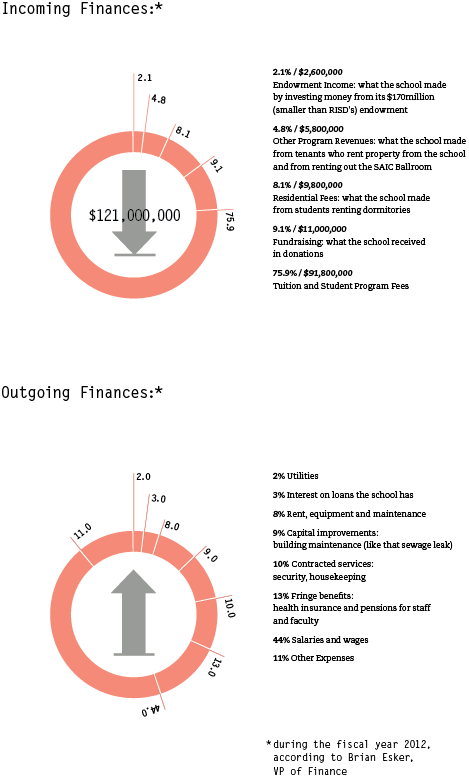How the School Spends its Tuition and Endowment Income

According to Abigail Rose Roberts, the Student Government’s comment boxes in the Neiman Center contained a handful of questions last semester about where The School of the Art Institute of Chicago’s (SAIC) money goes. For the most part, the school operates like any other. For example, SAIC has an endowment, a sum of money that has been donated to the school with the intention that the school will invest it in order to make money on interest while the principal amount remains intact. SAIC also has debt, money the school has borrowed to buy a building or equipment or make an improvement or do something else and is now paying back with interest.
Brian Esker, SAIC’s Vice President of Finance and Administration, very kindly broke it down for F Newsmagazine. One question students wanted answered was whether the school still pays its former president, Anthony Jones, who served for nearly 20 years. “No,” said Esker. Other students had asked whether SAIC is financing the Art Institute of Chicago’s debt. “No.”
Jones still does things for the school, said Esker, like speaking engagements, but he is no longer being paid. His title now is Chancellor Emeritus, a sort of retirement role, said Rose Milkowski, Vice President of Enrollment Management at the school. “It means you can go on campus,” Esker said. (According to the Internal Revenue Service, SAIC’s nonprofit 990 tax form reported that Anthony Jones received a more than $100K base compensation in fiscal year 2012.)
Esker confirmed, in response to a student inquiry, that the school’s and the museum’s finances are “pretty separate.” Except of course in places where it makes sense for them to share like human resources, legal support and other central administration. The school and museum share the cost of these salaries, pro-rated by how many hours are used by each. It is almost always cheaper to outsource services like security and housekeeping and building maintenance, so the school does that too.
Faculty pay was important to some students. Teachers are the people that help make SAIC students realize their potential. Nationally, tenured teaching positions only become fewer in number, but Esker said SAIC made a decision a number of years ago to offer part-time faculty benefits like health insurance and pensions. Elsewhere across the country, he said, “Part-time faculty are simply not benefitted, across the country.” The school budgets, said Esker, for 169 tenured track/visiting artist positions (benefited), 152 adjunct (benefited part-time), and 200-300 instructors (not benefited part-time).
Some students wanted to know the SAIC’s president’s salary. Walter Massey’s base compensation in the 2012 fiscal year, according to the 990, was close to half a million dollars. This is commensurate with those of presidents at some other world-class art schools in the US. The Rhode Island School of Design’s president during that school’s fiscal year 2012 made only slightly less, the President of the California College of the Arts made close to $400K and the Maryland Institute College of Art President made around $300K.







